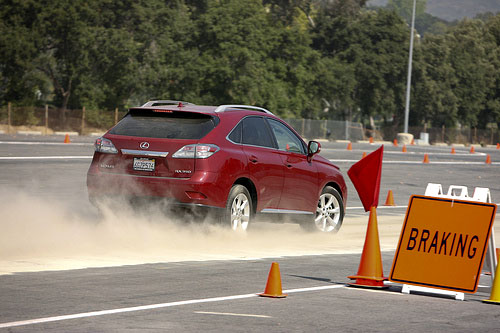Defensive Driving Rule Number 22: Know How To Stop!
Red light runners and account for a good portion of the traffic collision fatalities every year. It’s important to know how to stop.
Stopping a car safely is a crucial skill for any driver. Here are the steps to stop a car safely:
- Signal: If you’re driving on a road with other vehicles, use your turn signal to indicate your intention to stop. This alerts other drivers to your actions.
- Check Your Mirrors: Before you start to slow down, check your rearview mirror and side mirrors to be aware of the traffic behind you. This helps you make sure it’s safe to stop and gives you an idea of how other drivers are reacting.
- Brake Gradually: Begin to apply the brakes gently and progressively. Avoid slamming on the brakes, as this can lead to skidding or a sudden stop, which could be dangerous, especially in wet or slippery conditions.
- Downshift (Manual Transmission): If you’re driving a manual transmission car, downshift through the gears as you slow down. This can help slow the car and provide engine braking, reducing the strain on your brakes.
- Maintain Control: Keep both hands on the steering wheel and maintain control of the car. Avoid overreacting to the situation. Steer straight if possible while braking to avoid skidding.
- Look Ahead: Keep an eye on the road ahead to anticipate any obstacles or changes in traffic flow. This will help you adjust your braking and stopping distance.
- Increase Following Distance: If you’re following another vehicle, leave plenty of space between you and the car in front of you. The larger following distance gives you more time to react if the vehicle in front of you stops suddenly.
- Use Emergency Brake (If Necessary): If your regular brakes fail for some reason, you can use the emergency or parking brake (also known as the handbrake) to gradually slow the car down. Do this carefully, as it can cause your car to skid.
- Come to a Complete Stop: Continue braking until your car comes to a complete stop. If you’re at an intersection, stop behind the stop line or crosswalk.
- Shift to Neutral (Automatic Transmission): If you’re stopped for an extended period, such as at a long traffic light, consider shifting your automatic transmission into neutral and releasing the brake pedal to reduce wear on your transmission and brakes. Be prepared to shift back into Drive when it’s time to move again.
- Engage Parking Brake: When the car is completely stopped and you’re ready to exit, engage the parking brake (also known as the handbrake or emergency brake) and put the gear selector into “Park” (for automatic transmission) or in gear (for manual transmission).
- Observe Traffic and Proceed: Before you continue driving, make sure it’s safe to do so. Check traffic in all directions, including your blind spots, and proceed when it’s clear.
Remember, the key to safe braking is to be smooth and controlled. Sudden or aggressive braking can lead to accidents or skidding. Also, maintain your car’s brakes regularly, including checking brake fluid and brake pad wear, to ensure they are in good working condition.

